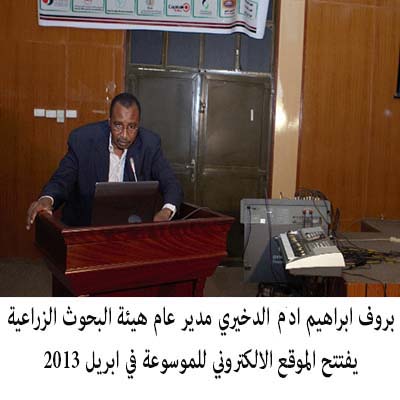إنتاج الالبان
Effect of Husbandry Practices on Milk Production in Dairy Farms in Sharg EL Neel Locality, Khartoum
كتب بواسطة: Administrator
Effect of Husbandry Practices on Milk Production in Dairy Farms in Sharg EL Neel Locality, Khartoum
By
Humam Al Noor Ahmed Mohamed
B.Sc. (Honours) in Animal Production.
College of Veterinary Medicine and Animal Production
Sudan University of Science and Technology
November – 2007
A thesis Submitted in Partial Fulfillment for the Requirements of the Degree of Master of Science in Animal Production
(Tropical Animal Production)
Supervisor
Dr. Ibtisam El yasMohamed El Zubeir
Department of Dairy Production
Faculty of Animal Production
University of Khartoum
March - 2011
ABSTRACT
The present study was designed to assess the present situation of dairy farms in Eastern Nile locality, Khartoum State with respect to management, husbandry practices and milk production performance. It was also aimed to outline the constraints facing dairy farming and to identify weakness points that need correction. A questionnaire and direct interviewing with sixty dairy farm’s owners; randomly chosen; at different locations were conducted during March – June 2010.
The study revealed highly significant (P<0.001) differences in the educational levels of farm’s owners. The education level of the farm owners showed negative and positive correlation with number of labours (r = - 0.264) and veterinary supervision (r = 0.273), respectively. Specialized dairy farming (38.33%) was found to be the most common type of dairy farming followed by diversified animal production (36.67%) and those integrated with crops (25%). The Nature of production showed positive correlation with power source (r = 0.385). High significant (P<0.001) differences in breed type was estimated, the predominant herds consisted of dairy cross cows (95%) with unknown foreign blood percentages because little attention was given to dairy records keeping. Only 36.33% farms had poorly designed records (P<0.001). There were correlation of breed type with farmer education (r = 0.281; P<0.01). Educational level farms owners reveled high significant positive correlation (P<0.01) with dairy records keeping (r = 0.275). The majority of herders (78.73%) had one or no breeding bull and the natural mating (48.33%) was found to be the widely method used for insemination of the herds. Various building materials such as wooden roof (66.67%), Zink fences (35.59%) and sandy floor (93.33%) were used without consideration of the proper space required for the cows (75%). High significant differences were obtained in lactation length. All farmers (100%) milked their cows by hands twice a day in the absent or present of the calves in order to stimulate milk ejection. Health services and preventive measures to control the diseases were not satisfactory, only 18.33% of the farms had resident veterinarian and the vaccinations are rarely (28%) administrated. Moreover, there were correlation of veterinary supervision with conducting feasibility study (r = 0.501; P<0.001), dairy records keeping (r = 0.364, P<0.001), labours number (r = 0.248; P<0.01), labours training (r = 0.267; P<0.01), udder examinations (r = 0.547, P<0.001), number of lactating cows (r = 0.279; P<0.01) and milk yield (r = 0.547, P<0.01). General hygiene and sanitation measures such as dung removal, disinfection, cleaning programs and maintaining minimal contamination during milking process were absent in the majority of the selected farms. Also culling strategy was very poor, as the need for cash was found to be the main reason for culling (43.33%). Green fodders and concentrates (96.67%) were found as the main feeding protocols (P<0.001) that offered twice a day, however the productivity of the cows was not considered in 55% of the farms.
Most of dairy producers are faced with many problems that constraint their production such as high ration price (78.67%), spread of epidemic diseases (25%), labours problems (18.33%) and difficulties in marketing of milk (16.67%). The price of milk showed highly significant positive correlation (P<0.01) with marketing procedures (r = 0.516). The present study concluded that most of farms under investigation are either not specialized dairy farms or operated on traditional basis.
المستخلص
أجريت هذه الدراسة لمعرفة الوضع الراهن لمزارع الألبان في منطقة شرق النيل ولاية الخرطوم٬في محاورالإدارة والعمليات الحقليةلإنتاج الألبان في تلك المزارع. كما هدفت الدراسة الى تحديد المعوقات التي تواجه إنتاج الألبان ونقاط الضعف التي تحتاج الى التصحيح. تم إختيار ومسح ستون مزرعة ألبانعشوائياً في عدة مواقع خلال الفترة مابين مارس و يونيو-2010. اعتمد في هذه الدراسة على أسلوب الإستبيان المكتوب والمقابلات الشخصية المباشرة مع أصحاب تلك المزارع.
أظهرت الدراسة وجود فرق معنوي كبير(P<0.001) في المستوى التعليمي للمربين.أوضح المستوى التعليمي للمربين ارتباط موجب وسالب مع أعداد العمال (r = - 0.264) والإشراف الصحي(r = 0.273) ، على الترتيب. كما وجد أن الغالبية العظمى من المزارع قد تم إنشاؤها دون إجراء دراسة جدوى مسبقة (r = - 0.369; P<0.01) كما تدار أغلب تلك المزارع بواسطة ملاك غير متخصصين (r = - 0.275; P<0.01) لا يهتمون بتأمين قطعانهم وهم يتلقون قدر ضئيل من الخدمات الإرشادية. لقد وجد أن مزارع الألبان المتخصصة تشكلالغالبية العظمى (38.33%) تليها المزارع المتنوعه(إنتاج حيواني-%36.67) ومن ثم المزارع التكاملية (إنتاج محاصيل- %25).أظهرت طبيعة الإنتاج ارتباط موجب مع مصدر كهرباء المزرعه(r = 0.385) . رصدت الدراسة وجود فرق معنوي كبير (P<0.001) في أنواع سلالات الأبقارالتي تتم تربيتها٬ حيث أن القطعان السائدة تتكون من أبقار هجين (95%) غير محددة بها نسبة الدم الأجنبي نظراً لأن الإحتفاظ بالسجلات المزرعية لا يجد اهتماما" من قبل المربين حيث أن36.33%فقط من المزارع تحتفظ بسجلات رديئة التصميم. وجد أن هناك إرتباط ما بيننوع السلالة والمستوى التعليمي للمربي (r = 0.281; P<0.01) . أظهر المتوى التعليمي للمربين ارتباط موجب معنوي (P<0.01) مع الإحتفاظ بسجلات اللبان(r = 0.275) . وجدت الدراسة أن 78.73%من المزارعين يحتفظون بثور واحد للتلقيح أو لا يحتفظون به٬ كما وجد أن التلقيح الطبيعي (48.33%) هو أكثر أنواع التلقيح استخدما". يتم استخدام العديد من مواد البناء مثل الأسقف الخشبية (66.67%) والأسوار المصممة من الزنك(35.59%) والأرضيات الرملية (93.33%)٬ علاوة على ذلك فإن % 75 من المربيين لم يراعوا المساحة المناسبةللأبقار.أظهرت نتائج الدراسة فروقات معنوية كبيرة في طول فترة الإدرار.ومن خلال نتائج الإستبيان فقد اتضح أن كل المزارعين (100%) يقومون بحلب أبقارهم يدوياً مرتين في اليومفي عدم وجودأو وجود العجول وذلك لتحفيز إدرار اللبن.فيما يتعلق بالخدمات الصحية والإجراءات الوقائية والتحكم في الأمراض فقد وجدت انها ليست بالمستوى المقبول٬حيث أن 18.33%فقط من المزارع يوجد بها طبيب بيطري بصورة دائمة٬ هذا بالإضافة الى أنه نادراً ما يكون هناك برنامج خاص لتحصين الأبقار ضد الأمراض حيث أنه يمارس فقط في 28% من المزارع. علاوة على ذلك٬ رصد ارتباط موجب معنوي قوي للإشراف الصحي مع إنشاء دراسة الجدوى (r = 0.501; P<0.001) ٬الإحتفاظ بسجلات الألبان(r = 0.364, P<0.001) ،أعداد العمال (r = 0.248; P<0.01) ،تدريب العمال (r = 0.267; P<0.01) ،إختبارات الضرع (r = 0.547, P<0.001) ،عدد الأبقار الحلوبة (r = 0.279; P<0.01) وكمية اللبن المنتج(r = 0.547, P<0.01) . من خلال الزيارات الحقلية لم يلاحظ اهتماما"بالصحة العامة وبرامج النظافة مثل إزالة الروث والتطهير والحفاظ على الحد الأدنى للتلوث خلال عملية الحلب في أغلب المزارع.أيضا لا تراعيغالبية المزارع استراتيجية استبعاد الأبقار من المزرعة الأسسالصحيحة حيث وجد أن السبب الرئيسي للإستبعاد هو الحوجة للمال (43.33%). وجد أن الأعلاف الخضراء والمركزات تقدم مرتين في اليوم كنظام أساسي للتغذية (P<0.001) بالرغم من أن 55% من المزارع لم تراعي انتاجية الأبقار عند التغذية.
هناك العديد من العقبات التي تواجه غالبية منتجي الالبان مثل إرتفاعأسعار العلائق (78.67%) وانتشار الأمراض الوبائية (25%) ومشاكل العمالة (18.33%) وصعوبةطريقة تسويق اللبن (16.67%). أظهر سعر اللبن ارتباط موجب معنوي (P<0.01) مع التسويق (r = 0.516). خلصت الدراسة الى أن معظم المزارع قيد الدراسة إما مزارع غير متخصصة أو يتم تشغيلها على أسس تقليدية.


